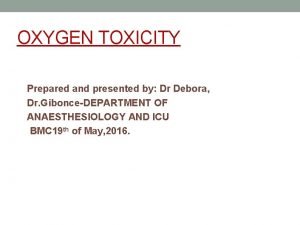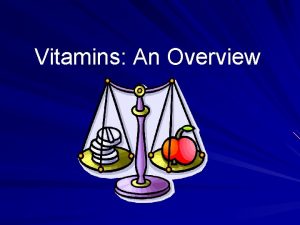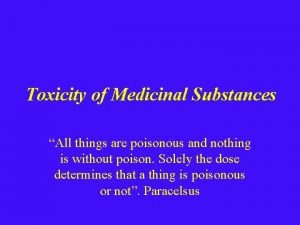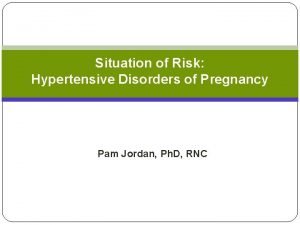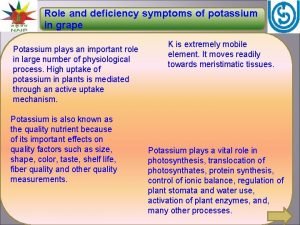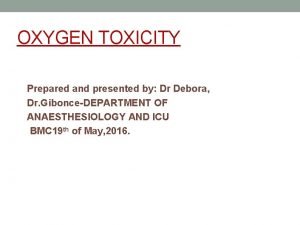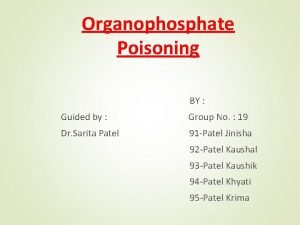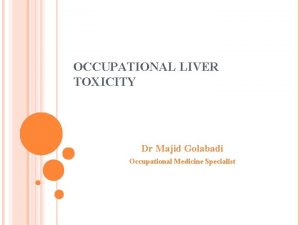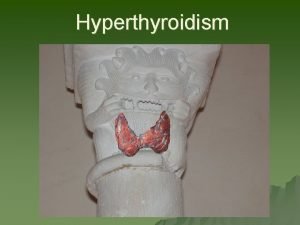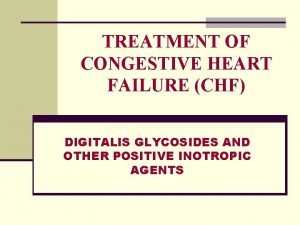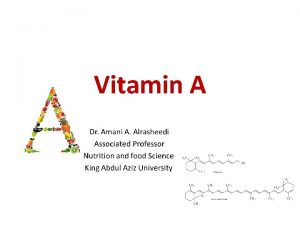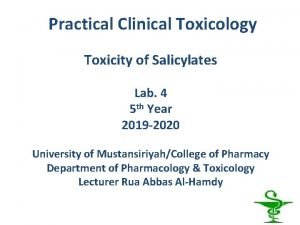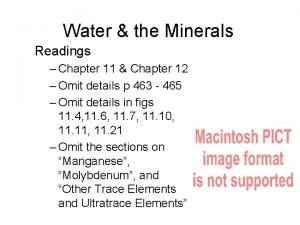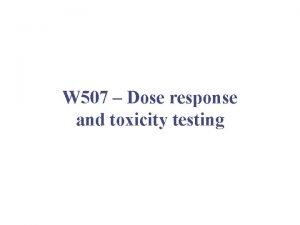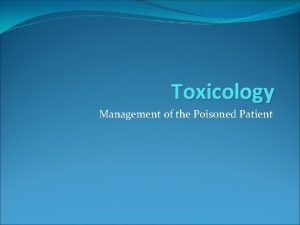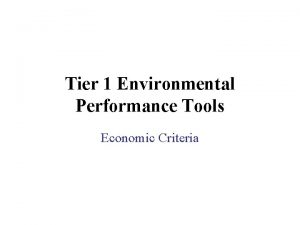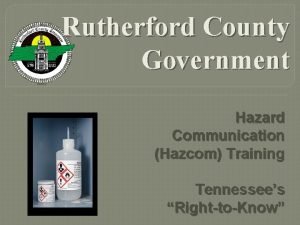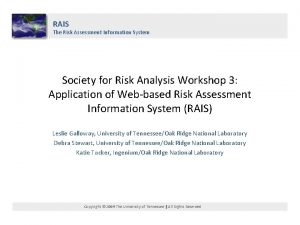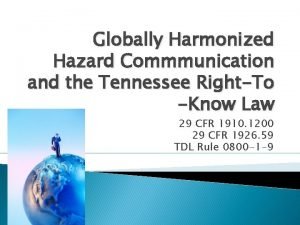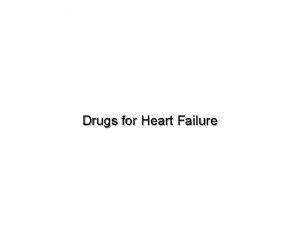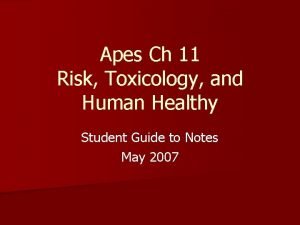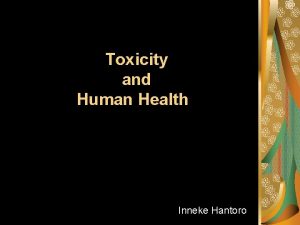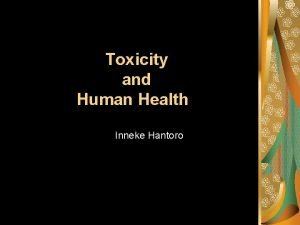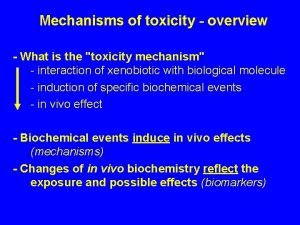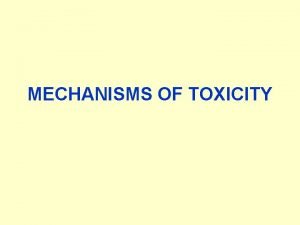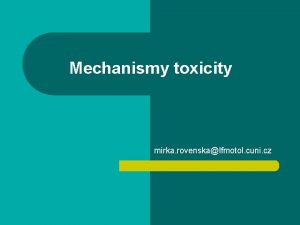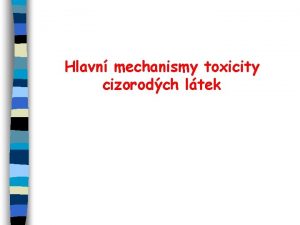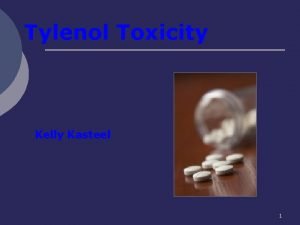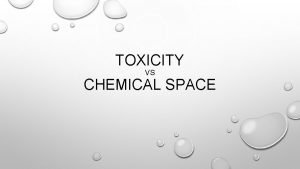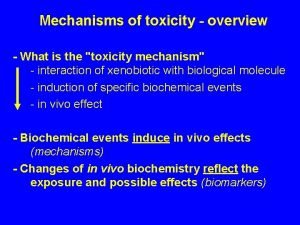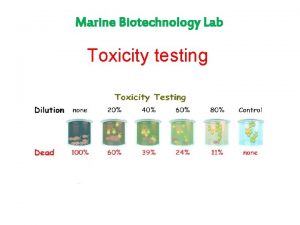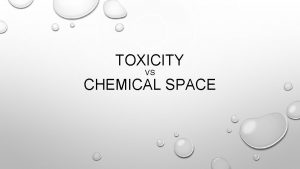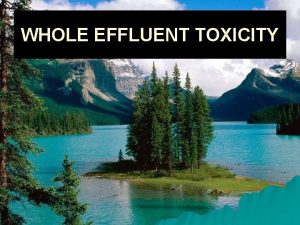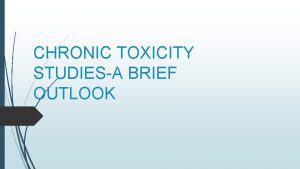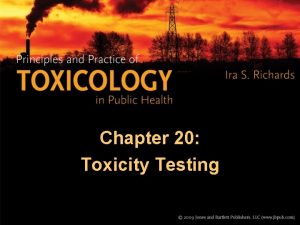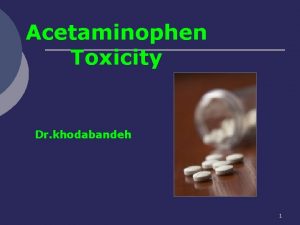Field Investigation of the Chemistry and Toxicity of





























































- Slides: 61

Field Investigation of the Chemistry and Toxicity of TPH in Petroleum Vapors: Implications for Potential Vapor Intrusion Hazards Roger Brewer & Lynn Bailey Hazard Evaluation and Emergency Response Hawai‘i Department of Health April 2012 1

There are three methods to gain knowledge: The first, reflection, is the noblest; The second, imitation, is the easiest; And the third, experience, is the bitterest. Confucius

Reference: Field Investigation of the Chemistry and Toxicity of TPH in Petroleum Vapors, Implications for Potential Vapor Intrusion Hazards: Hawai’i Department of Health, Hazard Evaluation and Emergency Response, http: //www. hawaiidoh. org/ Note: Significant vapor intrusion problems have not been identified for existing buildings at any of the study sites included in this presentation. The site data are presented for example only. 3

Acknowledgements • Field study funded under a grant from USEPA Region IX; • Hickam AFB/NAVFAC Hawai’i past work and field assistance • Field work carried out by HDOH HEER & UST staff with assistance by several local consultants; • Numerous consultations with regulators and consultants on the mainland. 4

HDOH Petroleum Vapor Intrusion Guidance • HEER EHE guidance (2005; last updated Fall, 2011) • HEER Technical Guidance Manual (Section 9); • Test for TPH plus BTEXN and methane in soil gas; • TPH soil gas action levels: • 2005: Residential = 26, 000 ug/m 3 (based on limited, published information); • 2011: Residential = 130, 000+ ug/m 3 (based on this study). 5

Vapor Intrusion vapor diluted advective flow into building Slab or crawl space diffusion to slab base Indoor Air Action Level Subslab Soil Gas Action Level Soil Gas ALres = 1, 000 x Indoor Air AL Soil Gas ALC/I = 2, 000 x Indoor Air AL contaminated soil or groundwater 6

Do We Really Need to Worry About TPH? How can something that smells so bad or can catch on fire pass a “risk assessment”? 7

Key Questions… 1. Are BTEXN and especially benzene in soil gas adequate to screen for potential vapor intrusion hazards at petroleum-contaminated sites? 2. Could TPH still pose a vapor intrusion risk even though BTEXN meet acceptable risks? a. What is the toxicity of TPH in petroleum vapors? b. What is carbon range makeup of vapor-phase TPH? 8

Fuels and Carbon Ranges Gasolines Diesel Fuels Fuel Oils Volatile/Semi-Volatile 69'C 126'C C 0 C 2 C 4 C 6 C 8 Methane BTEX 216'C C 12 343'C C 16 C 20 402'C C 24 449'C C 28 C 32 C 36 PAHs 9

Toxicity of Total Petroleum Hydrocarbons TPH Working Group (mid/late 1990 s) Subsequent Guidance • Massachusetts DEP (1997+) • Washington DOE (2006) • California EPA (DTSC 2009) • USEPA (2009) 10

Massachusetts DEP TPH Carbon Ranges Aromatics Gasolines Aliphatics Diesel Fuels Fuel Oils Potential Vapor Phase C 9 -10 C 11 -22 C 5 -8 C 0 C 2 C 4 C 6 C 8 C 9 -12 C 13 -18 C 16 C 19 -36 C 20 C 24 C 28 C 32 C 36 TPH = Sum of Aromatics + Aliphatics (excluding BTEXN, etc. ) 11

Vapor-Phase Carbon Ranges Aromatics Gasolines Aliphatics Diesel Fuels Fuel Oils Less Toxic More Toxic C 9 -16 C 5 -8 C 0 C 2 C 4 C 6 C 8 C 9 -18 C 12 C 16 C 20 C 24 C 28 C 32 C 36 TPH = Sum of Aromatics + Aliphatics (excluding BTEXN, etc. ) 12

Carbon Ranges - Vapor Sample Collection Volatile Petroleum Hydrocarbons (VPH): • C 5 -C 8 Aliphatics • C 9 -C 12 Aliphatics • C 9 -C 10 Aromatics Extractable Petroleum Hydrocarbons (EPH): • C 13 -C 16 Aliphatics • C 11 -C 16 Aromatics • VPH Compounds: Summa canisters OK • EPH Compounds: Sorbent tubes required 13

TPH Carbon Range Action Levels Carbon Range • • • Residential Rf. C Indoor Air Soil Gas (ug/m 3) C 5 -8 aliphatics 600 630, 000 C 9 -18 aliphatics 100 100, 000 C 9 -16 aromatics 100 100, 000 USEPA 2009 Reference Concentrations Target Hazard Quotient = 1. 0 Assumes indoor air: subslab soil gas Attenuation Factor of 0. 001 Odor Threshold (ug/m 3) approximately 1, 000 ug/m 3 Use same as action levels for BTEXN and other individual VOCs 14

TPH Mixtures: Weighted Toxicity & Action Levels 4. 7% Weighted TPH Rf. C= 216 ug/m 3 TPH Indoor Airres = 250 ug/m 3 TPH Soil Gasres = 250, 000 ug/m 3 30. 8% C 5 -8 Aliphatics: C 5 -C 8 Aliphatics 64. 5% C 9 -12 Aliphatics: C 9 -C 18 Aliphatics C 9 -10 Aromatics: C 9 -C 16 Aromatics Weighted TPH Rf. C (ug/m 3) = 15

Critical TPH: Target Compound Ratios • Point where relative proportion of “less toxic” vapor-phase TPH will overwhelm “more toxic” individual compounds Critical TPH Ratio = Least Stringent TPH Action Level Most Stringent Target Compound Action Level 3 (C 5 -C 8 aliphatics) 630 ug/m Critical TPH: Benzene Ratio = 0. 31 ug/m 3 (10 -6 cancer risk) Critical TPH: Benzene Ratio = 2, 032 • TPH will always drive vapor intrusion risk if the TPH: Benzene ratio exceeds 2, 032: 1 • Useful as initial screening tool to evaluate potential vapor intrusion risk drivers 16

TPH vs Benzene in Vapor Intrusion Risk TPH: Benzene Soil Gas Ratio >2, 032 Risk Driver TPH will always drive vapor intrusion risk (TPH HQ >1. 0 when benzene ECR <10 -6) 3 to 2, 032 TPH could drive vapor intrusion hazards (depends on carbon range makeup and target benzene risk) <3 Benzene will always drive vapor intrusion risk. (TPH HQ <1. 0 when benzene ECR <10 -4) Notes High: Ratio of least stringent TPH action level to most stringent benzene action level. Low: Ratio of least stringent TPH action level to most stringent benzene action level. 17

TPH Will Always Drive VI Risk if… Indoor Air Action Level (ug/m 3) Critical TPH Ratio Naphthalene 0. 072 8, 750 1 -Methylnaphthalene 0. 29 2, 172 Benzene 0. 31 2, 032 Ethylbenzene 0. 97 649 Xylenes 21 30 Toluene 1, 000 0. 6 VOC • Based on least conservative TPH action level (630 ug/m 3) and most conservative VOC action level (e. g. , 10 -6 cancer risk and HQ 1. 0). • TPH could drive vapor intrusion risk below these ratios depending on carbon range makeup and target risk applied to the individual VOC. 18

Off To The Field! • Key sites for collection of soil gas samples identified; • Two phases of sampling: • Phase I: Summas, TO-15 & MA-APH • Phase II: Summas+Sorbent Tubes, TO-3, TO 15, TO-17 & MA-APH 19

Summas or Sorbent Tubes for Soil Gas? (Summas will miss heavier VOCs) (Hayes 2007) Summas TO-15 TO-17 • Larger volume • Familiarity • Limited to C 12 C 0 C 2 C 4 C 6 C 8 Sorbent Tubes C 12 C 16 C 20 • Up to C 24+ • Small volume (50 ml) • Saturation limitation • Less familiar C 24 C 28 C 32 C 36 Summa Range Sorbent Tube Range 20

Key Study Sites Site A Site D Site C Site E Site B 21

Sample Collection Summa Canisters (1 liter summas) Sorbent Tubes (60 ml syringes) Max Draw = 50 ml Two Tubes to Evaluate Breakthrough 22

Results of Field Data • Following summaries based on Summa canister data • Sorbent tube data very similar to Summa data • Minimal VOCs greater than C 12 in soil gas • Naphthalene was usually ND and not a significant risk driver in comparison to TPH (or benzene) • TEX likewise not significant risk drivers 23

TPH Dominates BTEXN in Vapors (BTEXN component decreases in aged releases? ) Site/Fuel Type Gasoline (Fresh Vapors) Diesel (Fresh Vapors) JP-8 (Fresh Vapors) Site A (JP-4/AVGAS? ) Site B (mixed fuels) Site C (JP-8 +/- JP-4) Site D (MOGAS/JP-4/AVGAS) Site E (diesel) *Exhaust samples 30 -40% BTEXN Average Soil Gas Composition (TO-15 Data) TPH *BTEXN TPH: Benzene 91. 6% 8. 4% 170 93. 7% 6. 3% 206 96. 4% 3. 6% 301 99. 6% 0. 4% 1, 513 99. 5% 0. 5% 4, 174 99. 7% 0. 3% 18, 710 98. 3% 1. 7% 9, 135 99. 9% 0. 1% 18, 611 24

TO-15 Gas Chromatograph Fresh Gasoline Vapors C 5 -C 8 C 9 C 13 C 5 Benzene C 9 -12 Naphthalene 25

Carbon Range Chemistry and Weighted TPH Toxicity Fresh Gasoline Vapors 0. 8% 0. 4% Weighted Rf. C= 565 ug/m 3 Indoor Airres = 590 ug/m 3 Soil Gasres = 590, 000 ug/m 3 TPH: Benzene = 170 C 5 -8 Aliphatics: C 5 -C 8 Aliphatics C 9 -12 Aliphatics: C 9 -C 12 Aliphatics C 9 -10 Aromatics: C 9 -C 10 Aromatics 98. 8% Based on TO-15 Summa Data

Who’s Driving…? TPH vs Benzene as VI Risk Driver • Calculate equivalent TPH concentration for sample/site at target benzene action level based on TPH: Benzene ratio • Divide by weighted site-specific TPH action level Gasoline Vapor Example (using indoor air action levels): • Target Benzene Action Level = 0. 31 ug/m 3 (10 -6 risk) • TPH: Benzene = 170: 1 • Equivalent TPH = 53 ug/m 3 • Weighted TPH Action Level = 590 ug/m 3 • TPH noncancer HQ = 53/590 = 0. 1 • Benzene drives vapor intrusion risk (TPH HQ <1. 0 when benzene risk = 10 -6) 27

2 10 -6 1 0 TPH HQ=0. 1 Benzene 0 Benzene Cancer Risk TPH Hazard Quotient TPH vs Benzene Vapor Intrusion Risk Fresh Gasoline Vapors TPH vs Benzene Risk Based on TO-15 Summa Data Benzene adequate to evaluate vapor intrusion provided that a target 10 -6 cancer risk is used. (TPH noncancer HQ still <1 when benzene risk 10 -6) 28

TO-15 Gas Chromatograph Fresh Diesel Vapors C 5 -C 8 C 5 C 9 -12 C 9 Benzene C 13 Naphthalene 29

Carbon Range Chemistry and Weighted TPH Toxicity Fresh Diesel Vapors Weighted Rf. C= 216 ug/m 3 Indoor Airres = 250 ug/m 3 Soil Gasres = 250, 000 ug/m 3 TPH: Benzene = 206 4. 7% 30. 8% 64. 5% C 5 -8 Aliphatics: C 5 -C 8 Aliphatics C 9 -12 Aliphatics: C 9 -C 12 Aliphatics C 9 -10 Aromatics: C 9 -C 10 Aromatics Based on TO-15 Summa 30 Data

2 1 10 -6 TPH 0 Benzene HQ=0. 3 TPH vs Benzene Risk 0 Benzene Cancer Risk TPH Hazard Quotient TPH vs Benzene Vapor Intrusion Risk Fresh Diesel Vapors Based on TO-15 Summa Data Benzene adequate to evaluate vapor intrusion provided that a target 10 -6 cancer risk is used. (TPH noncancer HQ still <1 when benzene risk 10 -6) 31

Gas Chromatograph Fresh JP-8 Vapors C 5 -C 8 C 5 C 9 -12 C 9 Benzene C 13 Naphthalene 32

Carbon Range Chemistry and Weighted TPH Toxicity Fresh JP-8 Vapors Weighted Rf. C= 225 ug/m 3 Indoor Airres = 230 ug/m 3 Soil Gasres = 230, 000 ug/m 3 TPH: Benzene = 301 0. 6% 32. 8% C 5 -8 Aliphatics: C 5 -C 8 Aliphatics C 9 -12 Aliphatics: C 9 -C 12 Aliphatics C 9 -10 Aromatics: C 9 -C 10 Aromatics 66. 6% Based on TO-15 Summa 33 Data

2 1 10 -6 TPH 0 Benzene HQ=0. 4 TPH vs Benzene Risk 0 Benzene Cancer Risk TPH Hazard Quotient TPH vs Benzene Vapor Intrusion Risk Fresh JP-8 Vapors Based on TO-15 Summa Data Benzene adequate to evaluate vapor intrusion hazards provided that a target 10 -6 cancer risk is used. (TPH noncancer HQ<1 when benzene risk 10 -6) 34

Gas Chromatograph Site A (AVGAS) C 5 -C 8 C 5 C 9 -12 C 9 Benzene C 13 Naphthalene 35

Carbon Range Chemistry and Weighted TPH Toxicity Site A (AVGAS) 3. 3% 0. 2% Weighted Rf. C= 510 ug/m 3 Indoor Airres = 530 ug/m 3 Soil Gasres = 530, 000 ug/m 3 TPH: Benzene = 1, 513! (reduced benzene in soil gas) C 5 -8 Aliphatics: C 5 -C 8 Aliphatics C 9 -12 Aliphatics: C 9 -C 12 Aliphatics C 9 -10 Aromatics: C 9 -C 10 Aromatics 96. 5% Average TPH in Soil Gas 71, 000 ug/m 3 Based on TO-15 Summa 36 Data

2 1 10 -6 TPH 0 Benzene HQ=0. 9 TPH vs Benzene Risk 0 Benzene Cancer Risk TPH Hazard Quotient TPH vs Benzene Vapor Intrusion Risk Site A (AVGAS) Based on TO-15 Summa Data Benzene adequate to evaluate vapor intrusion hazards provided that a target 10 -6 cancer risk is used. (TPH noncancer HQ<1 when benzene risk 10 -6) 37

Where’s the BTEXN? Partitioning of Compounds in Soil Chemical/ Carbon Range Benzene Ethylbenzene Toluene Xylenes Naphthalene C 9 -C 10 Aromatics C 11 -C 22 Aromatics C 5 -C 8 Aliphatics C 9 -C 12 Aliphatics C 9 -C 18 Aliphatics C 19 -C 36 Aliphatics *Henry’s Constant 0. 23 0. 32 0. 27 0. 29 0. 018 0. 33 0. 03 54 65 69 110 *Theoretical ratio of vapor-phase mass to dissolved-phase mass at equilibrium. Dissolved-phase dominates if H’ <1. 0. Aromatics Prefer to be in the Water Aliphatics Prefer to be in the Vapors 38

Gas Chromatograph Site B (Mixed Fuels) C 5 -C 8 C 5 Benzene C 9 -12 C 9 C 13 Naphthalene 39

Carbon Range Chemistry and Weighted TPH Toxicity Site B (Mixed fuels) 0. 3% 6. 8% Weighted Rf. C= 443 ug/m 3 Indoor Airres = 460 ug/m 3 Soil Gasres = 460, 000 ug/m 3 TPH: Benzene = 4, 174! (reduced benzene in soil gas) C 5 -C 8 Aliphatics C 5 -8 Aliphatics: C 9 -C 12 Aliphatics C 9 -12 Aliphatics: C 9 -C 10 Aromatics C 9 -10 Aromatics: 92. 9% Average TPH in Soil Gas 44, 000 ug/m 3 Based on TO-15 Summa 40 Data

3 2 TPH 1 HQ=2. 8 Benzene 0 TPH vs Benzene Risk 10 -6 0 Benzene Cancer Risk TPH Hazard Quotient TPH vs Benzene Vapor Intrusion Risk Site B (Mixed Fuels) Based on TO-15 Summa Data TPH always drives potential vapor intrusion hazards. (TPH noncancer HQ>1 even when benzene risk 10 -6) 41

Gas Chromatograph Site C (JP-8 +/- J-4) C 5 -C 8 C 5 Benzene C 9 -12 C 9 C 13 Naphthalene 42

Carbon Range Chemistry and Weighted TPH Site C (JP-8 +/- JP-4) Weighted Rf. C= 251 ug/m 3 Indoor Airres = 260 ug/m 3 Soil Gasres = 260, 000 ug/m 3 TPH: Benzene = 18, 710!! 0. 6% (minimal benzene in soil gas) 27. 1% C 5 -C 8 Aliphatics C 5 -8 Aliphatics: C 9 -C 12 Aliphatics C 9 -12 Aliphatics: C 9 -C 10 Aromatics C 9 -10 Aromatics: 72. 2% Average TPH in Soil Gas 17, 000 ug/m 3 Based on TO-15 Summa 43 Data

25 20 15 10 5 0 TPH HQ=22 Benzene TPH vs Benzene Risk 10 -6 0 Benzene Cancer Risk TPH Hazard Quotient TPH vs Benzene Vapor Intrusion Risk Site C (JP-8 +/- J-4) Based on TO-15 Summa Data TPH always drives potential vapor intrusion hazards. (TPH noncancer HQ>1 even when benzene risk 10 -6) 44

TO-15 Gas Chromatograph Site D (JP-4) C 5 -C 8 C 5 C 9 -12 C 9 C 13 Benzene Naphthalene 45

Carbon Range Chemistry and Weighted TPH Site D (JP-4) Weighted Rf. C= 211 ug/m 3 Indoor Airres = 220 ug/m 3 Soil Gasres = 220, 000 ug/m 3 TPH: Benzene = 9, 135! 4. 1% (minimal benzene in soil gas) 32. 6% 63. 3% C 5 -8 Aliphatics: C 5 -C 8 Aliphatics C 9 -12 Aliphatics: C 9 -C 12 Aliphatics C 9 -10 Aromatics: C 9 -C 10 Aromatics Average TPH in Soil Gas 630, 000 ug/m 3 Based on TO-15 Summa 46 Data

15 10 TPH 5 HQ=13 Benzene 0 TPH vs Benzene Risk 10 -6 0 Benzene Cancer Risk TPH Hazard Quotient TPH vs Benzene Vapor Intrusion Risk Site D (JP-4) Based on TO-15 Summa Data TPH always drives potential vapor intrusion hazards. (TPH noncancer HQ>1 even when benzene risk 10 -6) 47

Gas Chromatograph Site E (Diesel) C 5 -C 8 C 5 C 9 -12 C 9 Benzene C 13 Naphthalene 48

Carbon Range Chemistry and Weighted TPH Site E (Diesel) *Reference site for default TPH Rf. C in Fall 2011 TPH soil gas action levels. Weighted Rf. C= 127 ug/m 3 Indoor Airres = 130 ug/m 3 Soil Gasres = 130, 000 ug/m 3 TPH: Benzene = 18, 600!! 0. 9% 25. 3% (minimal benzene in soil gas) C 5 -8 Aliphatics: C 5 -C 8 Aliphatics C 9 -12 Aliphatics: C 9 -C 12 Aliphatics C 9 -10 Aromatics: C 9 -C 10 Aromatics 73. 8% Average TPH in Soil Gas 2, 900, 000 ug/m 3 Based on TO-15 Summa 49 Data

50 40 30 20 10 0 TPH HQ=44 Benzene TPH vs Benzene Risk 10 -6 0 Benzene Cancer Risk TPH Hazard Quotient TPH vs Benzene Vapor Intrusion Risk Site E (Diesel) Based on TO-15 Summa Data TPH always drives potential vapor intrusion hazards. (TPH noncancer HQ>1 even when benzene risk 10 -6) 50

TPH vs Benzene as Vapor Intrusion Risk Driver TPH *Benzene Drives Risk X X X Site/Fuel Type Gasoline (Fresh Vapors) Diesel (Fresh Vapors) JP-8 (Fresh Vapors) Site A X (JP-4/AVGAS? ) Site B X (mixed fuels) Site C X (JP-8 +/- JP-4) Site D X (MOGAS/JP-4/AVGAS) Site E X (diesel) *Assuming a target, 10 -6 cancer risk is used for benzene. X 51

Other Sites TPH vs BTEXN Site/Fuel Type HAFB SS 156 -E (gasolines) Conoco. Phillips (mixed) Lipoa Place (mixed) Challenger Loop (JP-4, JP-8) TPH: Benzene In Soil Gas 244 to 1, 296 97 to 5, 400 82 to >6, 400 2, 800 to 5, 100 Aloha Petroleum (gasolines) 366 to 13, 100 HAFB SS 156 -J (mixed) 560 to 165, 000 HAFB CG 110 (diesels) 1, 600, 000 • TPH: Benzene ratio highly variable • Best to always test for TPH 52

Back to the Key Questions… Q: What is TPH in petroleum vapors made of? Answers: • Mostly C 5 -C 8 aliphatics, with an increased proportion of C 9+ aliphatics in middle distillate (diesel, etc. ) vapors. • Aromatics, including BTEXN, make up a very minor component of vapors, especially at aged release sites. 53

Key Questions… Q: What is the toxicity (Rf. C) of TPH in petroleum vapors? Answer: • Inhalation Reference Concentration for TPH will range from 100 ug/m 3 and 600 ug/m 3 (based on USEPA 2009 guidance). • Vapors from gasolines will be closer to 600 ug/m 3. (dominance of C 5 -C 8 aliphatics) • Vapors from middle distillates will be closer to 100 ug/m 3 (presence of C 9 -C 12 aliphatics) • TPH Indoor air action levels similar to TPH Rf. C 54

Key Questions… Q: Are BTEXN and especially benzene in soil gas adequate to screen for potential vapor intrusion risks? Answers (more studies needed): • Yes – But only for gasoline-contaminated sites and only if a conservative target risk is used (e. g. , 10 -6 ); • Aromatics can be preferentially removed from vapors via partitioning into moisture and degradation (but aliphatics will also be degraded); • Reliance on benzene only can miss significant vapor intrusion hazards at diesel/middle distillate sites; • TX not present in significant enough amounts to drive vapor intrusion risks at the study sites (ethylbenzene? ); • Naphthalene not detected in most soil gas samples and not a reliable indicator of vapor intrusion risk. 55

Key Questions… Q: Can TPH still pose a vapor intrusion risk even though BTEXN meet acceptable risks? Answers: • Yes - TPH drives vapor intrusion risk over BTEXN at four of the five sites tested; • TPH data especially important at sites with middle distillates (but vapor emission rates will be lower compared to gasolines); • TPH alone would have been adequate to screen all of the study sites for potential vapor intrusion hazards (i. e. , take care of the TPH and you will take care of the benzene). 56

Already Here & Coming Soon • Study data used to update HEER TPH soil gas action levels (based on Fishing Village data); • Draft report to be posted in March; • Final report to be posted this spring; • Methylnaphthalenes? (not significant in this study); • Updated TPH Carbon Range guidance and soil gas sample collection guidance to be posted this summer; • Comments and ideas always welcome. Now we know what the source area looks like… 57

Next Step: Pre-Screening Sites for Potential Vapor Intrusion Concerns Don’t Panic! Rf Vapor Intrusion Biodegradation BTEXN TP H Ca R rbo an n ge s Fs A Subslab Cs 58

Avoid Setting The Site Screening Bar Too Low • When do we need to look more closely (screening levels)? • When is remediation really required (high risk sites)? High Risk Remedial Action Ultimately Required (don’t miss) Medium Risk Flagged in Screening but No Action Ultimately Required (minimize) Low Risk Site Screening Bar Eliminated During Screening, No Further Action Required (maximize) Risk Pyramid of Investigated Sites 59

Avoid Setting The Site Screening Bar Too High Risk Remedial Action Ultimately Required (don’t miss) Site Screening Bar Medium Risk Flagged in Screening but No Action Ultimately Required (minimize) Low Risk Eliminated During Screening, No Further Action Required (maximize) Risk Pyramid of Investigated Sites 60

Screening Sites for Further Investigation Let’s Be Rational. . . : • Don’t over compound conservative screening assumptions (e. g. , “Tomb Model” for IA: SG attenuation and target 10 -6 risk); • Biodegradation and attenuation away from source area; • Distance from source area; • De minimis volumes of contaminated soil and areas of free product (regardless of concentrations); • Other considerations: -Alternative toxicity factors; -Target risks vs typical background; -Tidal pumping &subslab oxygenation -Explosion, odor concerns (including methane); -Focus on subslab data. • Avoid testing indoor air (too many indoor & outdoor sources) • Balance uncertainty about benefit to human health with certainty about economic impact on property owners. 61
 Vce chemistry research investigation example
Vce chemistry research investigation example Poxymeter
Poxymeter B6 toxicity symptoms
B6 toxicity symptoms Vitamin d toxicity
Vitamin d toxicity Definition of chronic toxicity
Definition of chronic toxicity Vitamin a toxicity
Vitamin a toxicity Magnesium sulfate toxicity level
Magnesium sulfate toxicity level Plant name
Plant name What is oxygen toxicity
What is oxygen toxicity Organophosphate toxicity
Organophosphate toxicity Hepatic toxicity
Hepatic toxicity Lithium toxicity
Lithium toxicity Synthesis defintion
Synthesis defintion Which pictogram represents acute toxicity
Which pictogram represents acute toxicity Definition of chronic toxicity
Definition of chronic toxicity Dig toxicity
Dig toxicity Apap
Apap Anticholinergic syndrome
Anticholinergic syndrome Alcohol toxicity
Alcohol toxicity Vitamin c history
Vitamin c history Digoxin uses
Digoxin uses Retinol function
Retinol function Treatment of salicylate toxicity
Treatment of salicylate toxicity Water fluid
Water fluid W 507
W 507 B complex action
B complex action Lithium toxicity
Lithium toxicity Toxicity index
Toxicity index Acute toxicity
Acute toxicity Rais risk
Rais risk Mountains into molehills mass-mole conversions answer key
Mountains into molehills mass-mole conversions answer key Acute toxicity
Acute toxicity Digoxin toxicity mnemonic
Digoxin toxicity mnemonic Apes 2004 frq
Apes 2004 frq Electric field and magnetic field difference
Electric field and magnetic field difference Q factor of capacitor
Q factor of capacitor Database field types and field properties
Database field types and field properties Field dependent and field independent
Field dependent and field independent Difference between electric field and magnetic field
Difference between electric field and magnetic field Individual differences factors
Individual differences factors Field dependent vs field independent
Field dependent vs field independent Waveguide cutoff frequency
Waveguide cutoff frequency Ib organic chemistry
Ib organic chemistry Organic vs inorganic chemistry
Organic vs inorganic chemistry Hát kết hợp bộ gõ cơ thể
Hát kết hợp bộ gõ cơ thể Frameset trong html5
Frameset trong html5 Bổ thể
Bổ thể Tỉ lệ cơ thể trẻ em
Tỉ lệ cơ thể trẻ em Gấu đi như thế nào
Gấu đi như thế nào Tư thế worm breton
Tư thế worm breton Chúa sống lại
Chúa sống lại Kể tên các môn thể thao
Kể tên các môn thể thao Thế nào là hệ số cao nhất
Thế nào là hệ số cao nhất Các châu lục và đại dương trên thế giới
Các châu lục và đại dương trên thế giới Cong thức tính động năng
Cong thức tính động năng Trời xanh đây là của chúng ta thể thơ
Trời xanh đây là của chúng ta thể thơ Mật thư tọa độ 5x5
Mật thư tọa độ 5x5 Làm thế nào để 102-1=99
Làm thế nào để 102-1=99 Phản ứng thế ankan
Phản ứng thế ankan Các châu lục và đại dương trên thế giới
Các châu lục và đại dương trên thế giới Thơ thất ngôn tứ tuyệt đường luật
Thơ thất ngôn tứ tuyệt đường luật Quá trình desamine hóa có thể tạo ra
Quá trình desamine hóa có thể tạo ra

